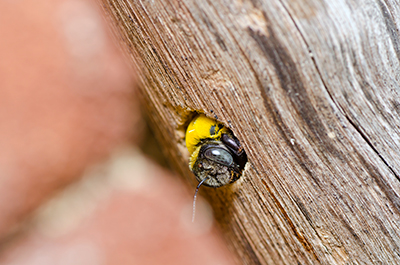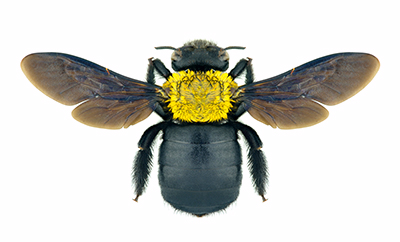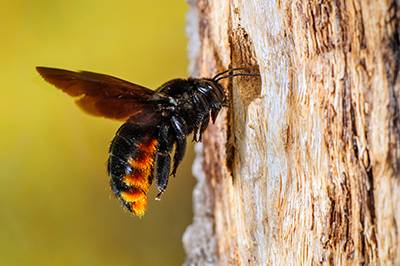Carpenter Bee Prevention, Treatment – First Signs of Carpenter Bees
 Do you see small 1/2 inch diameter holes in your home’s siding, your deck, a wooden play structure, a pile of lumber or a stack of firewood? Is a single bee entering and emerging from the neat entrance hole, or hovering around the entrance? You probably have discovered a carpenter bee nest, drilled into the wood in or around your home.
Do you see small 1/2 inch diameter holes in your home’s siding, your deck, a wooden play structure, a pile of lumber or a stack of firewood? Is a single bee entering and emerging from the neat entrance hole, or hovering around the entrance? You probably have discovered a carpenter bee nest, drilled into the wood in or around your home.
Carpenter Bee Prevention, Treatment – Where and when to look for Carpenter Bees
Here’s the ideal spot for a carpenter bee nest:
- Unfinished wood (or wood where the finish has worn or cracked)
- Uneven wood (once again, worn, cracked, splintered, prior carpenter bee nest sites)
- Soft wood (redwood, cedar, pine…etc.)
- Wood located in direct sunlight
When are carpenter bees most active?
Carpenter bees begin to become active in April, peak in activity in May and then gradually decline until they drop off of the radar in October.
Carpenter Bee Activity Chart Based on Google Searches
What do carpenter bees look like?
 Carpenter bees are large, as bees go, and have a shiny abdomen. They are loners. You won’t see multiple bees emerging from and entering into a carpenter bee nest. In this way they are unlike yellow jackets, honey bees, bumble bees and other insects that establish colonies.
Carpenter bees are large, as bees go, and have a shiny abdomen. They are loners. You won’t see multiple bees emerging from and entering into a carpenter bee nest. In this way they are unlike yellow jackets, honey bees, bumble bees and other insects that establish colonies.
Carpenter Bee Prevention, Treatment – Are carpenter bees a problem?
When we think of bee problems, we often think of getting stung. As you pass near the entrance hole of a carpenter bee nest, the bee may fly about aggressively and look dangerous. It’s all an act! The good news is that you’re very unlikely to get stung by a carpenter bee. The males cannot sting, and the females need to be provoked in o rder to sting.
rder to sting.
So, what’s the problem with carpenter bees?
Unlike termites, carpenter bees don’t eat wood. They just drill their neat hole for a nesting place to raise their young. They’ll drill about an inch directly into the wood, and then make a 90 degree turn to follow the wood grain for another six inches. The female then subdivides the long part of the tunnel into about 6-10 compartments, laying an egg in each compartment, then stocking it with pollen to feed the newborn.
Direct Damage Caused by Carpenter Bees
Compared to termites, and even carpenter ants, that 6-inch carpenter bee hole does not cause much damage to the wood… at least directly. But here’s the problem: Next year, another carpenter bee will find that exposed, abandoned nest, move in and expand the nest. Bees that appear in subsequent years will continue to expand the nest. Now what began as a small hole becomes a gradually expanding network of tunnels, potentially breaking through into your home. And, a site that is inviting to one carpenter bee will be inviting to others. Additional holes are drilled, nests that will gradually expand.
Indirect Damage Caused by Carpenter Bees
So, you have this gradually expanding network of tunnels in your home’s siding, deck or play structure. Now add to this the indirect damage. The tunnels invite moisture, resulting in wood rot. Furthermore, wood peckers, sensing carpenter bee activity beneath the surface will do what wood peckers do best: Begin pecking at the wood, digging through to capture and eat the bee inside. You could end up with a wood surface that is totally splintered and destroyed!
Carpenter Bee Prevention, Treatment – How to discourage carpenter bees in the first place.
Fortunately, it’s pretty easy to discourage carpenter bees. Just smooth and paint all exposed wood with a coat of exterior paint or a polyurethane finish. It’s important to prepare the wood before painting. Caulk any cracks, fill any divots, make it very smooth. If there are carpenter bee holes from previous years, shove some steal wool into these, seal them off with an exterior wood filler, sand and paint.
Note: Make sure there are no living carpenter bees in the holes before you seal them. Why? They’ll continue digging into the wood until they finally tunnel to freedom–perhaps the inside of your house?! You’re pretty safe sealing carpenter bee holes in non-carpenter bee season (see above chart).
Also, be sure to seal wood that you cannot see including the back side and underside of boards.
Cover firewood piles and stacks of lumber.
At this point, just to make sure you’ve made all the potential carpenter bee nest sites “unfriendly” to carpenter bees, call in a professional for a thorough carpenter bee and pest inspection:
Call ApolloX Pest Control
(888) 499-7378
We’re trained, licensed and experienced to locate all the potential and current nesting sites of carpenter bees. In addition, we’ll inspect your home for other pest issues (mice, rats, cockroaches, carpenter ants, termites, moths, bed bugs and wood boring beetles…just to mention a few).
Why go through the prevention sequence multiple times throughout the pest season, and potentially experience costly pest damage because you missed one of the common pests?
Carpenter Bee Prevention, Treatment – Exterminating Carpenter Bees
So, let’s say you’re at the height of the carpenter bee season (the month of May), and you see one or more carpenter bee nest holes on or around your home with bees flying in and out and buzzing you every time you get close. Here’s a line of attack:
- Immediate Control: If there are many bees, you could use an aerosol insecticide to establish an immediate control of the situation. But note that this is only a temporary solution that lessens the problem and makes the longer term fix more manageable.
- Long Term Solution: The most effective insecticide for carpenter bees comes in the form of a dust. Apply insecticide dust to the entrance of the carpenter bee nest. Do this while the bees are inactive. The best times are at night, and during their off-season (see the chart above).
- Sealing the Nest: Once you’re convinced the carpenter bee is dead (you might wait a few days after applying the dust), fill the tunnel with steal wool or a dowel and wood glue, apply exterior wood filler to smooth out the entrance, sand the wood and paint the surface with an exterior paint or polyurethane finish.
Carpenter Bee Prevention, Treatment – Conclusion
Carpenter bees, though not dangerous to humans, and not as damaging as termites, wood beetles and carpenter ants, can still destroy a wooden surface and underlying structure. It’s best to take preventive action by making the wood surfaces on or around your home or business “carpenter bee unfriendly”. And, regularly inspect for the presence of carpenter bees, especially during the month of April – June, and take quick action if you discover carpenter bee activity.
Be safe and sure, get a professional home or business pest inspection.
Call ApolloX Pest Control
(888) 499-7378













Recent Comments